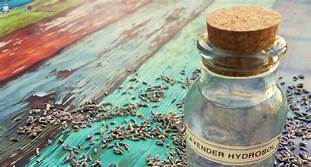







Protocols - Hydrosols
The standard dilution rate for the internal use of hydrosols for therapy is thirty millilitres (two tablespoons) of hydrosol diluted in one litre (thirty-two-ounces) of water. If you wish only to flavour your water, use the smallest amount necessary to give the desired intensity of taste. Of course, using only a tiny amount of hydrosol does not mean that it does not have an effect on the person.
Hydrosols are very powerful, physically and vibrationally. I have already discussed the homeopathic comparison, so do bear this in mind if you flavour your water on a regular basis. Never choose a hydrosol with properties that may be in appropriate to your body or mind. You will often be drawn to what you need, but it is always important to check the properties of any given hydrosol before you start using it.
In holistic health, treatments are often given on a three-week basis. You use the remedy, oil, herb, or preparation every day for three weeks, then stop for one week. The body needs time to register, process, and then incorporate changes and adjustments that the treatment has made to be assimilated.
You allow the health to come to a new balance, a new homeostasis, After seven days without treatment you will be able to reassess the health condition and make a better decision on what else was needed , if anything. If you keep making changes without cease, the body does not have time to catch up, and you may continue treatment longer than is necessary or advisable, Use respect, less is more.
Reference: Hydrosols: The Next Aromatherapy: Suzanne Catty
Articles - Most Read
- Home
- What are Hydrosols
- What are Hydrosols-2
- The Monographs
- How to Make a Hydrosol
- Table of Common Latin Names and pH Values - F - O
- Distilled or Extracted Specifically For Therapeutic Use - 3
- What isn't a Hydrosol?
- Kurt Schnaubelt
- Table of Common Latin Names and pH Values - P - S
- Wholly Water!
- Blue Babies
- Mature Skin
- Supply and Demands
- Recipes Alpha F
- Hydrosols In The Marketplace
- Hemorrhoids
- Nelly GrosJean
- Chemicals: Friends or Foes?
- Water as Medicine
- Genitically Modified Plants
- Water Quality
- Influences
- The Educated Consumer
Articles-latest
- Comptonia peregrinal/Sweet Fern- pH 3.8
- Citrus clementine (fe) Clementine Petitgrain- pH 4.3-4.4
- Citrus aurantium var. amara (flos) /Neroli Orange Blossom-pH3.8-4.5
- Cistus ladaniferus/Rock Rose-pH 2.9-3.1
- Cinnamomum zeylanicum (ec) Cinnamon Bark-pH3.3
- Chamaemelum nobile/Roman Chamomile - pH 3.0-3,3
- Centaurea cyanus/Cornflower/Bachelor's Button-pH 4.7-5.0
- Cedrus atlantical/Cedarwood/Atlas Cedar-pH 4.1- 4.2
- Hydrosols -The PH - Anomalies
- Hydrosols- Establishing Shelf Life and Stability
- Boswellia carterii/FRANKINCENSE
- Asarum canadense/ Wild Ginger/Canadian Ginger
- Artemesia vulgaris / Artemesia
- ARTEMESIA DRACUNCULUS - TARRAGON
- Angelica archangelica / Angelica Root - Hydrosols
- The Key, or More Correctly, the pH - 2 - Hydrosols
- The Key, or More Correctly, the pH-Hydrosols
- The Hard pHacts - Hydrosols
- Calamus Root/Sweet Flag - ACORUS CALAMUS
- Yarrow - Achillea millefolium - Hydrosols
- Balsam Fir - Abies balsamea - Hydrosols
- How the Monograps are Presented
- The Three-Week Internal Protocol - Hydrosols
- Protocols - Hydrosols

